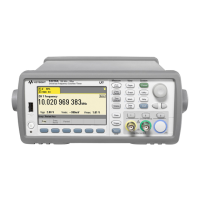
Do you have a question about the Agilent Technologies 53220A and is the answer not in the manual?
| Brand | Agilent Technologies |
|---|---|
| Model | 53220A |
| Category | Cash Counter |
| Language | English |
Identifies manual part number and edition details.
Information on obtaining software updates and license terms.
Disclaimers, legal notices, and warranty terms for the product.
Essential safety practices for operation, power-on, and grounding.
Warnings against hazardous environments, unauthorized modifications, and damage.
Guidelines for safe instrument cleaning and handling damaged units.
Information regarding compliance with the WEEE directive for product disposal.
Guidance on lithium battery replacement intervals and proper disposal.
General hazard warnings, safety symbols, and grounding requirements.
Critical warnings for input connections, signal polarity, and battery operation.
Precautions for installation, modification, damage, and cleaning.
Description of front/rear panels, display, instrument details, and included accessories.
Specifications for environmental conditions during operation and storage.
Details on power supply, consumption, and line voltage requirements.
Explains power-on LED status and the function of standby power.
Information on using, charging, and maintaining the instrument's battery.
Accessing help, utility functions, display settings, user interaction, and reference settings.
Overview of the user guide's content structure.
Specifies software requirements and development environments for instrument control.
How to connect and use the instrument's web interface for control.
Guide for installing essential software libraries and instrument drivers.
Steps for configuring LAN, USB, and GPIB interfaces for PC connection.
How to use the Interactive IO utility for sending SCPI commands.
Procedures for updating instrument firmware and associated drivers.
Information on using emulation modes for compatibility with older SCPI sets.
Overview of available measurements, SCPI commands, and channel restrictions.
How to configure the instrument's internal or external reference oscillator source.
Details on setting measurement modes, time outs, and SCPI syntax.
Covers frequency, frequency ratio, and period measurement types and commands.
Explains single and dual-channel time interval, rise/fall, pulse width, duty cycle, phase.
Procedures for measuring burst carrier frequency, PRI, PRF, and pulse widths.
Details on input channels, signal path, and specifications.
Settings for input impedance, protection relays, and overload conditions.
How to set input range and probe factor for accurate measurements.
Configuration for AC/DC coupling and bandwidth limiting (low-pass) filter.
How to set threshold levels, sensitivity, auto-level, and noise rejection.
Setting trigger slope and measuring input signal levels.
Summary of trigger and gate settings, time lines, and cycles.
How to configure system trigger source, slope, delay, count, and sample count.
Details on setting gate source, time, polarity, and advanced controls.
How to configure gate sources and times for frequency measurements.
Configuration of gate sources and times for totalizing measurements.
How to set gate sources, polarity, and thresholds for time interval measurements.
Specific gating configurations for burst carrier frequency measurements.
Managing gate start, stop hold off, and automatic gate extension.
Overview of smoothing, scaling, statistics, limit checking, and enabling math subsystems.
How to create, view, and configure histograms and trend charts.
Procedures for data logging, saving readings, and managing data.
How graphics functions interact with reading memory and reset operations.
Details on ASCII and REAL data formats and data transfer mechanisms.
How to specify data format and control block transfer byte order.
Diagram and explanation of data movement within the counter and to external devices.
How to create, manage, and use folders and files in internal/external memory.
Setting up custom configurations for instrument power-on.
Procedures for deleting, copying, and moving files and folders.
Introduction to the status system and registers for monitoring instrument conditions.
Monitors conditions affecting measurement integrity like overload and errors.
Monitors operational conditions like calibration, battery status, and trigger states.
Monitors programming conditions including operation complete and errors.
Summarizes status bits from other registers and manages service requests.
Lists and describes errors related to command syntax, parameters, and data types.
Details errors related to command execution, hardware issues, and configuration.
Errors related to file operations, storage media, and access.
Covers system errors, I2C communication issues, and calibration-related errors.
Lists errors identified during self-tests and other specific device issues.